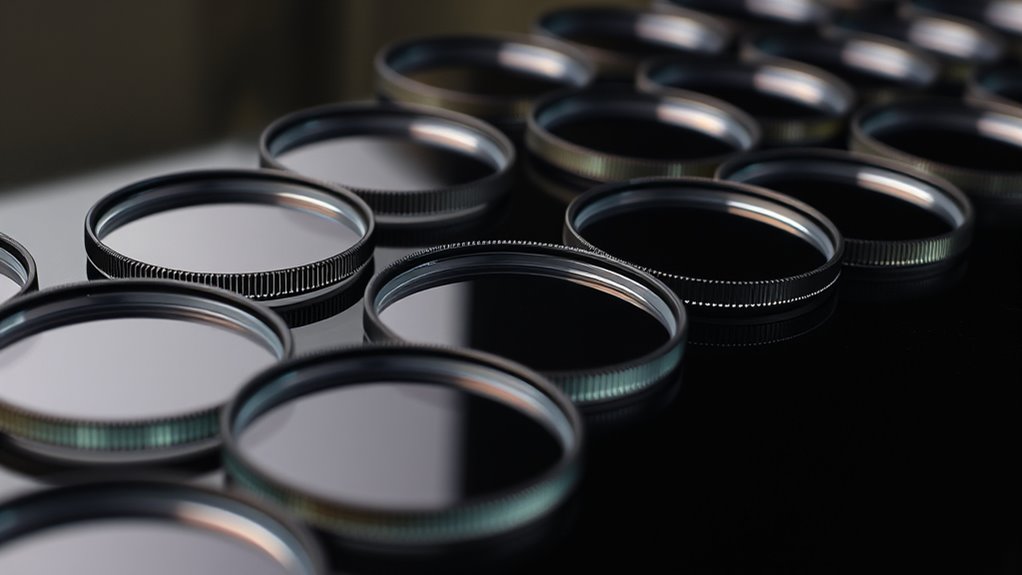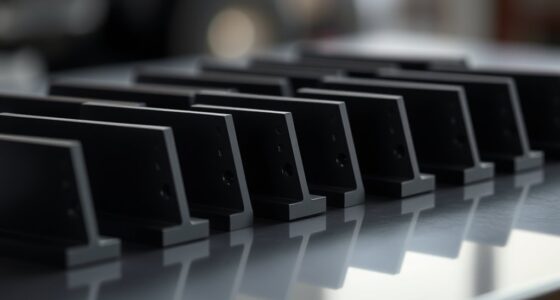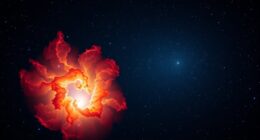If you’re after crystal-clear photography, I recommend checking out top 1.25-inch UV IR cut filters from trusted brands like Astromania, SVBONY, and OPTOLONG. These filters effectively block UV and IR light, boosting contrast, sharpness, and color accuracy in planetary and deep-sky imaging. They also protect your sensors and improve focus. To find the best fit for your setup, you’ll want to evaluate compatibility, coating quality, durability, and cost—plus, here’s more on each option.
Key Takeaways
- Look for filters with high light transmission (up to 98%) and multi-coatings for optimal clarity and contrast.
- Ensure compatibility with standard 1.25-inch threaded eyepieces and cameras to prevent fitting issues.
- Choose reputable brands like OPTOLONG, SVBONY, or Breakthrough for durable build quality and reliable optical performance.
- Prioritize filters with anti-reflective coatings that block UV and IR wavelengths effectively for sharper images.
- Consider ultra-slim, double-threaded designs to avoid vignetting during planetary and deep-sky astrophotography.
Astromania 1.25 IR/UV Blocking Filter – Keeps Your Planetary Images Sharp
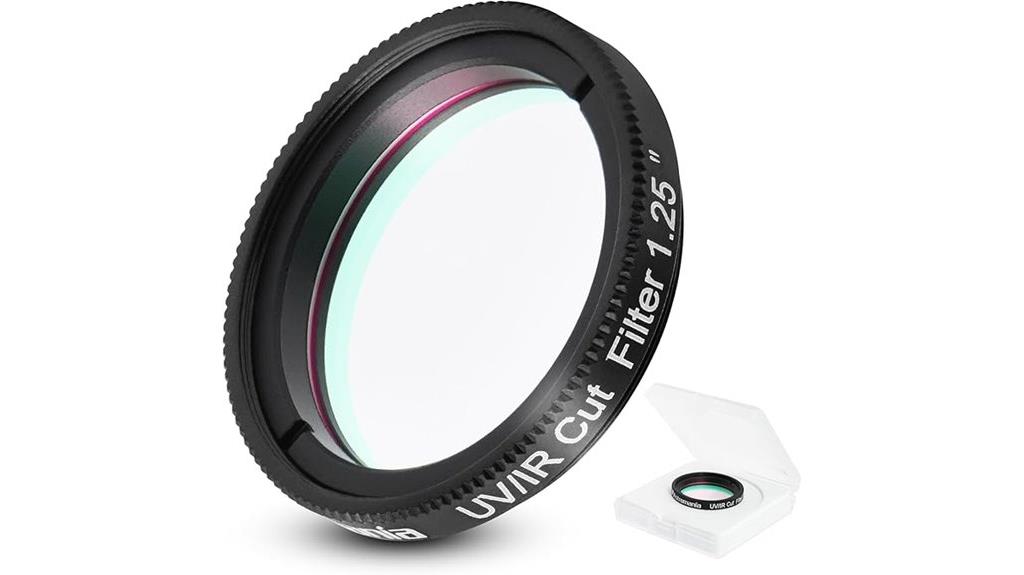
If you’re serious about capturing sharp, detailed planetary images, the Astromania 1.25 IR/UV Blocking Filter is an excellent choice. It filters out harmful UV and IR light, allowing only visible wavelengths between 400-680nm to reach your camera or telescope. This reduces chromatic aberration, glare, and out-of-focus issues, resulting in crisper, more focused images of planets like Jupiter and Saturn. The filter’s optical polish and durable aluminum casing ensure high quality and easy compatibility with standard 1.25-inch eyepieces and cameras. Overall, it’s a simple yet effective tool to improve image clarity and detail in planetary astrophotography.
Best For: amateur astronomers and astrophotographers seeking to enhance planetary imaging by reducing chromatic aberration and improving image sharpness with a reliable IR/UV blocking filter.
Pros:
- Effectively filters out UV and IR light to improve image clarity and detail.
- Compatible with standard 1.25-inch eyepieces and cameras for easy use.
- Durable, optically polished with a robust aluminum casing ensuring high quality and longevity.
Cons:
- May require additional filters for specific imaging needs or to further enhance results.
- Some users might notice minimal visible change due to IR and UV light being invisible to the human eye.
- Not specialized for astrophotography beyond planetary imaging, limiting its use for deep-sky objects.
Astromania 1.25 IR/UV Blocking Filter – Keeps Your Planetary Images Sharp

The Astromania 1.25 IR/UV Blocking Filter is an excellent choice for astronomers aiming to capture sharp, detailed planetary images. It selectively transmits visible light (400-680nm) while blocking harmful UV and IR wavelengths, ensuring your images stay crisp and in focus. This filter is especially beneficial for CCD camera use and planetary imaging with webcams. Its optically polished, coated surface enhances clarity, and the durable aluminum casing makes it easy to handle during observations. Plus, it protects your eyes from UV rays that can cause damage over time. Overall, this filter offers a simple yet effective way to improve image quality and safeguard your vision.
Best For: amateur astronomers and astrophotographers seeking to capture sharp, detailed planetary images with their CCD cameras or webcams while protecting their eyes from harmful UV rays.
Pros:
- Effectively blocks UV and IR wavelengths to enhance image clarity and focus
- Durable aluminum casing ensures long-lasting use and easy handling
- Protects eyesight from harmful UV rays that can cause damage over time
Cons:
- Only compatible with 1.25-inch telescope accessories and cameras
- May require additional filters for comprehensive imaging needs
- Slight additional cost for specialized planetary imaging compared to standard filters
SVBONY 1.25 Inch UV IR Cut Telescope Filter
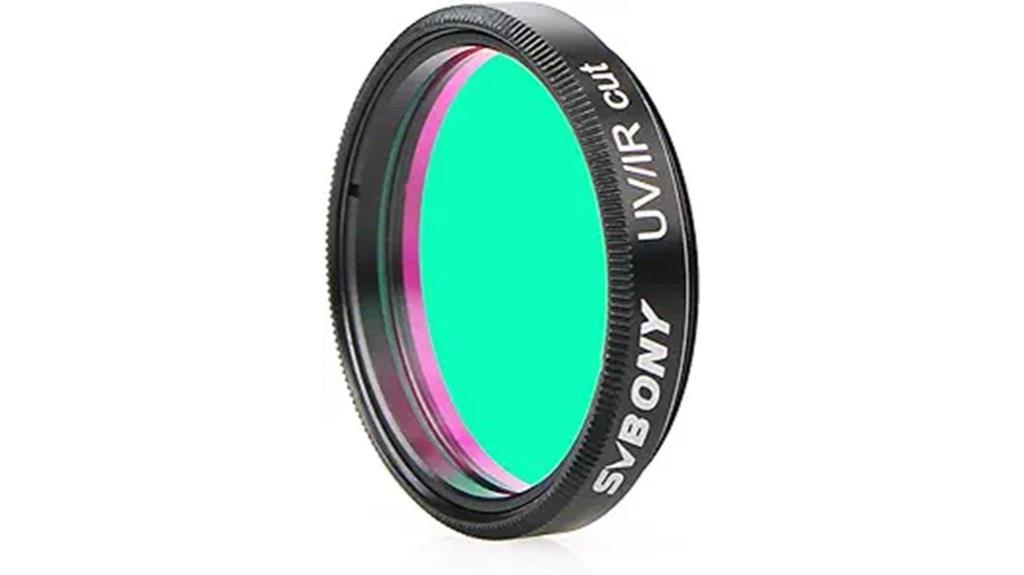
The SVBONY 1.25 Inch UV IR Cut Telescope Filter stands out as an excellent choice for amateur astronomers and astrophotographers seeking sharp, high-contrast images. It effectively blocks ultraviolet and infrared rays, enhancing detail and color accuracy in planetary, lunar, and deep-space shots. Built with true optical glass and multi-coatings, it reduces chromatic aberration and unwanted emissions. Compatible with standard 1.25″ threads, it also doubles as a lens protector for various cameras and telescopes. Lightweight and easy to handle, it’s praised for its affordability and solid performance, making it a practical option for both beginners and experienced stargazers alike.
Best For: amateur astronomers and astrophotographers seeking an affordable, effective UV IR cut filter to enhance planetary, lunar, and deep-space imaging.
Pros:
- Blocks ultraviolet and infrared rays to improve image contrast and color accuracy
- Constructed with true optical glass and multi-coatings for sharp, detailed images
- Compatible with standard 1.25″ threads and doubles as a lens protector
Cons:
- May have surface stains or dust that could affect performance if not cleaned properly
- Some users report minor gradients or reflections under high illumination conditions
- Slightly limited in premium build quality compared to high-end filters
OPTOLONG 1.25 UV/IR Cut Filter for CCD Digital Astrophotography
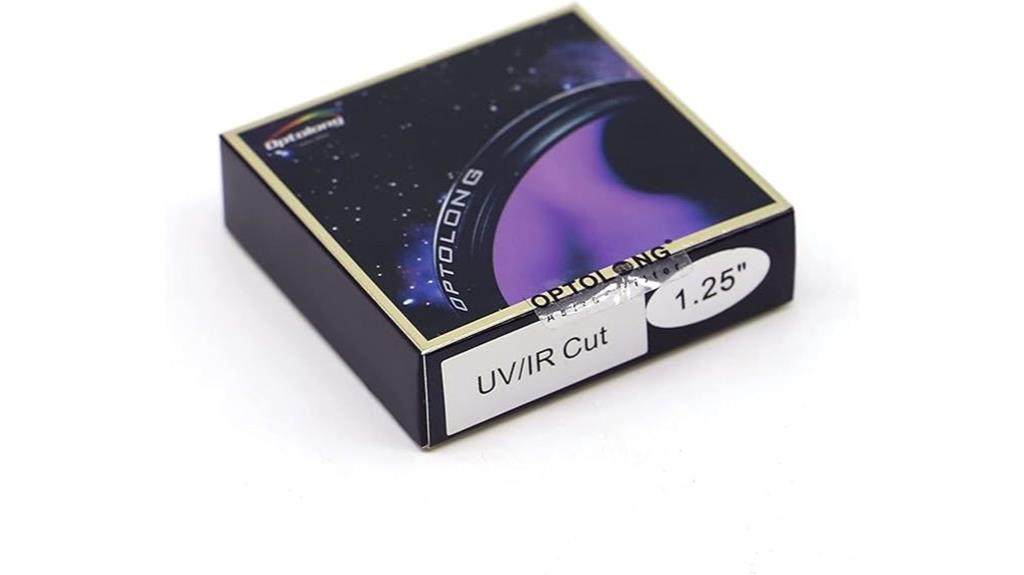
Designed for serious astrophotographers, the OPTOLONG 1.25 UV/IR Cut Filter enhances CCD digital imaging by effectively blocking unwanted ultraviolet and infrared wavelengths. It improves contrast and brightness across celestial objects, making details stand out sharply. Compatible with various telescopes and parfocal with other Optolong filters, it guarantees seamless integration during imaging sessions. With high transmission at key wavelengths like H-beta and OIII, and blocking of others, it reduces light pollution and atmospheric interference. Made from durable, scratch-resistant glass, it offers long-lasting performance. Users praise its ability to reduce star bloating and boost overall image clarity, making it an excellent choice for both amateurs and professionals.
Best For: serious astrophotographers and advanced amateur astronomers seeking to improve CCD imaging with enhanced contrast, brightness, and long-lasting durability.
Pros:
- High transmission rates at key wavelengths (e.g., H-beta, OIII) improve image clarity and detail.
- Effectively blocks ultraviolet and infrared wavelengths to reduce light pollution and atmospheric interference.
- Made from durable, scratch-resistant glass with multi-coatings for long-term performance and reliability.
Cons:
- Slightly narrow transmission bandwidth may limit some imaging applications.
- Compatible with 1.25-inch focusers but may require adapters for certain setups.
- Requires careful handling to avoid scratches despite its scratch-resistant construction.
Astromania 1.25 IR/UV Blocking Filter – Keeps Your Planetary Images Sharp
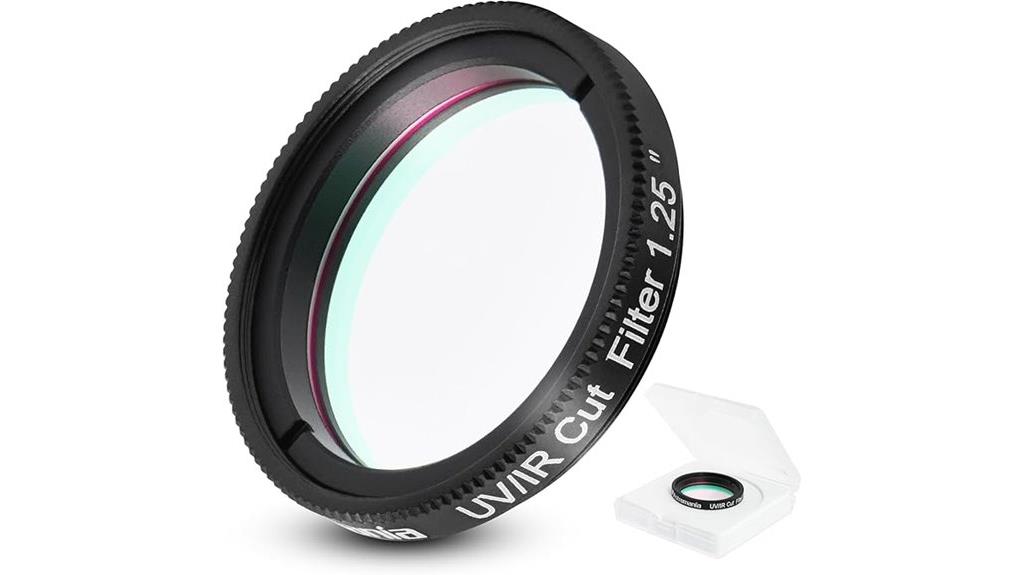
If you’re serious about capturing sharp, detailed planetary images, the Astromania 1.25 IR/UV Blocking Filter is an excellent choice. It blocks UV and IR light, which can cause blurriness and color distortion, and allows only visible light between 400-680nm. This results in clearer, more focused images of planets like Jupiter and Saturn. The filter reduces glare and chromatic aberration, enhancing fine detail and overall image quality. Made from optically polished, coated glass and housed in a durable aluminum casing, it’s easy to attach to standard 1.25-inch eyepieces or cameras, making it a valuable tool for astrophotographers seeking sharper planetary shots.
Best For: astrophotographers and amateur astronomers seeking to capture sharp, detailed planetary images with reduced chromatic aberration and enhanced clarity.
Pros:
- Blocks UV and IR light to produce clearer, more focused planetary images
- Reduces glare and chromatic aberration for improved detail and sharpness
- Durable, optically polished glass housed in a robust aluminum casing for easy attachment
Cons:
- Some users may require additional filters for specific imaging needs
- IR and UV light are invisible to the human eye, so effects may not be immediately obvious visually
- Designed primarily for planetary imaging; less effective for deep-sky astrophotography
Telescope Filter 1.25 Inch UV IR Cut Block Filter
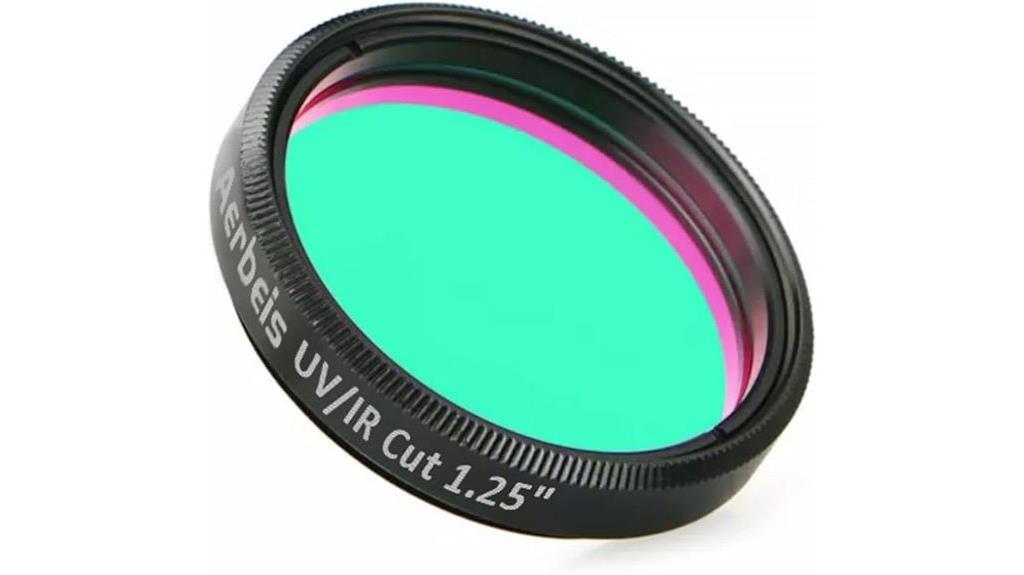
For amateur astronomers seeking sharper, more vibrant images, the Telescope Filter 1.25 Inch UV IR Cut Block Filter offers a compelling solution. Its aluminum alloy frame and multi-layer coated optical glass guarantee durability and high optical quality. The filter effectively corrects color casts, enhances clarity, and improves image fidelity in natural environments. It reduces reflections, boosts contrast, and makes celestial objects like the moon and planets stand out. Designed for easy installation, it threads smoothly onto compatible equipment and stacks well with other filters. Its lightweight build and versatile performance make it a reliable choice for planetary, astrophotography, and stargazing adventures.
Best For: amateur astronomers and astrophotographers seeking to enhance image clarity, contrast, and color fidelity during planetary observation and stargazing.
Pros:
- Durable aluminum alloy frame with multi-layer coated optical glass for high-quality performance
- Effectively reduces reflections and polarized scattered light, improving contrast and vibrancy
- Easy to install and stack with other filters, suitable for various observational targets
Cons:
- Minor surface scratches may be present upon arrival; handle with care
- Slippery thin profile requires careful handling during installation
- Limited to 1.25-inch diameter, requiring compatible telescope or camera equipment
Breakthrough Photography X1 UV Filter for Camera Lenses
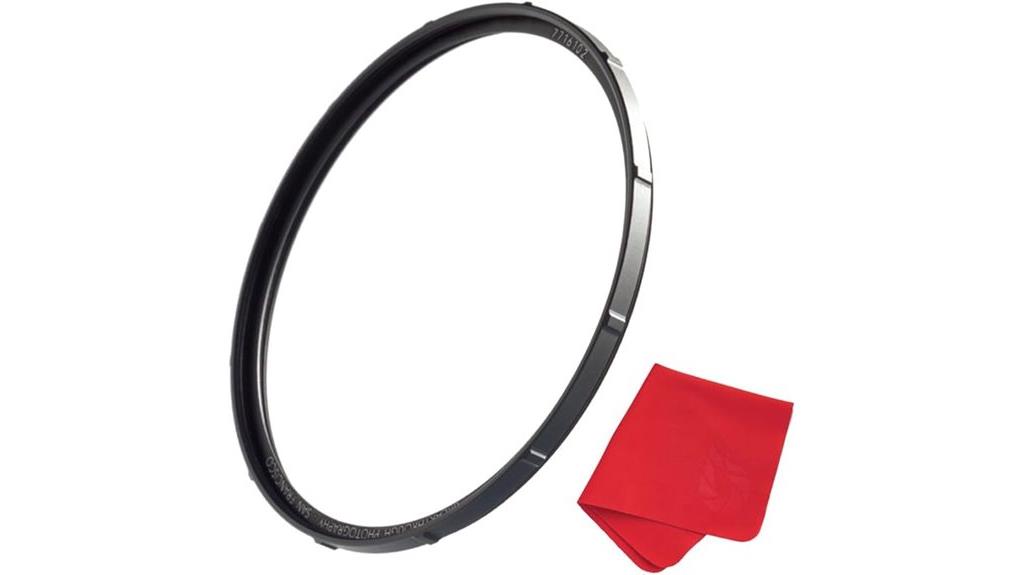
The Breakthrough Photography X1 UV Filter stands out for photographers who prioritize both clarity and durability. Made with high-quality AGC Japanese glass and featuring 4-layer MRC coatings, it effectively reduces flaring and ghosting for sharper images. Its ultra-slim, double-threaded design prevents vignetting on wide-angle full-frame lenses, while the improved grip makes installation and removal easier. Built with weather-sealed construction, it protects against dust, water, and environmental elements, ensuring your lens stays safe. Backed by a 25-year support and a laser-engraved serial number, this filter combines longevity with reliable performance, making it a smart choice for demanding outdoor photography.
Best For: photographers seeking high-quality lens protection with minimal impact on image clarity, especially those using wide-angle full-frame cameras in outdoor or challenging environmental conditions.
Pros:
- Crafted with high-quality AGC Japanese glass and 4-layer MRC coatings for superior image clarity and reduced flaring.
- Ultra-slim, double-threaded design prevents vignetting on wide-angle full-frame lenses.
- Weather-sealed construction offers robust protection against dust, water, and environmental elements.
Cons:
- Designed specifically for 39mm lenses, limiting compatibility with other sizes.
- May be priced higher than basic UV filters due to premium materials and coatings.
- Requires proper handling to avoid scratches or smudges on the high-precision glass surface.
Telescope Filter, 1.25 inch UV IR Cut Filter
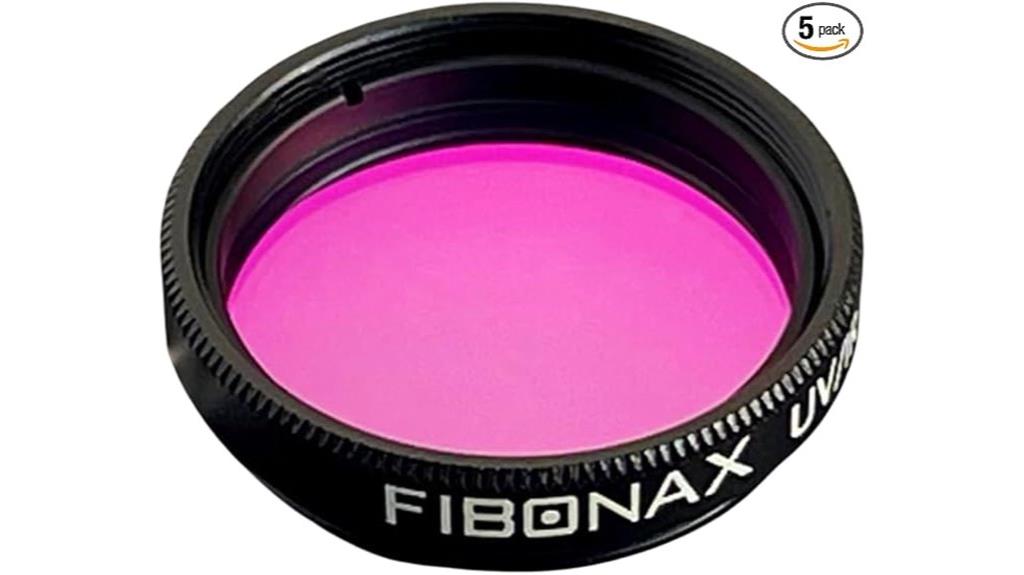
A 1.25-inch UV IR Cut Filter is an excellent choice for amateur astronomers and astrophotography enthusiasts seeking clear, sharp celestial images. This multi-coated filter blocks infrared and ultraviolet light, ensuring high visible light transmission from 400nm to 780nm. Its lightweight aluminum frame and double-thread design allow easy stacking with other filters or accessories. It effectively reduces star bloat, enhances image sharpness, and corrects color distortions—ideal for viewing the moon, planets, and stars. While some IR leakage concerns exist, many users find it offers good value for beginners and hobbyists looking to improve their astrophotography results without breaking the bank.
Best For: amateur astronomers and astrophotography enthusiasts seeking an affordable, easy-to-use filter to improve celestial imaging and observation.
Pros:
- High visible light transmission (400nm-780nm) for clear, sharp images of the moon, planets, and stars
- Multi-coated, durable aluminum frame allows stacking with other filters for versatile use
- Lightweight and easy to clean, making it suitable for beginners and portable setups
Cons:
- Potential IR leakage which may cause artifacts during imaging
- Some users report color distortions like green hues on the moon
- Not compatible with all advanced imaging setups; performance may vary depending on equipment
Telescope Filter, 1.25 Inch UV IR Cut Block Filter
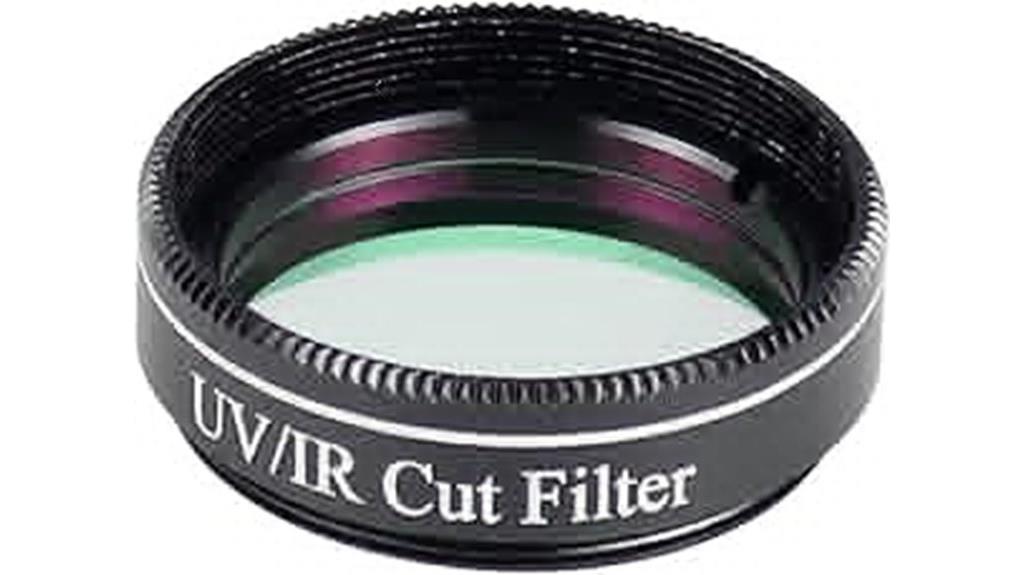
If you’re serious about capturing sharp, high-contrast images through your telescope, the 1.25-Inch UV IR Cut Block Filter is an essential accessory. This filter effectively blocks ultraviolet and infrared light, ensuring your images remain crisp and detailed. With a 98% light transmission rate, it minimizes detail loss while reducing ghost images thanks to its low-reflection multi-coating. Its durable metal frame and high-quality glass ensure longevity and stability during use. Ideal for moon and deep-sky observation, it enhances contrast and detail, especially in light-polluted areas. Plus, it’s compatible with other filters, making it a versatile choice for serious astronomers.
Best For: Serious amateur and professional astronomers seeking to enhance image clarity, contrast, and detail during moon and deep-sky observations, especially in light-polluted environments.
Pros:
- High 98% light transmission minimizes detail loss while filtering out unwanted UV and IR light
- Durable metal frame and high-quality glass ensure long-lasting stability and optical fidelity
- Effectively reduces sky glow and violet halos around bright stars, improving image contrast
Cons:
- May be less effective at reducing sky glow near the horizon compared to zenith, limiting performance in certain conditions
- Requires compatible 1.25-inch telescope accessories; not suitable for larger or different-sized filters
- Slightly more expensive than basic filters, though offers superior optical quality and durability
SVBONY 1.25-inch UV IR Cut Filter for Telescope and CCD Camera

Designed specifically for telescope optics, CCD cameras, and video cameras, the SVBONY 1.25-inch UV IR Cut Filter offers versatile compatibility with C-mount adapters. It’s built with true optical glass and multi-coatings, ensuring minimal reflection and maximum clarity. The striate-free, plane parallel substrate enhances image sharpness and detail. Its UV and IR blocking capabilities improve image quality by reducing unwanted light interference, especially useful for astrophotography and high-precision imaging. The standard 1.25-inch threads make it easy to attach to eyepieces and accessories. Plus, it comes in a protective box, keeping it safe and clean when not in use.
Best For: amateur astronomers, astrophotographers, and imaging enthusiasts seeking high-quality UV/IR filtering for their telescope and camera setups.
Pros:
- Constructed with true optical glass and multi-coatings for minimal reflection and maximum clarity
- Striate-free, plane parallel substrate enhances image sharpness and detail
- Versatile compatibility with C-mount adapters, eyepieces, and accessories
Cons:
- Designed specifically for 1.25-inch systems, limiting use with larger formats
- Requires careful handling to avoid scratches on the optical surface
- May need additional adapters for certain equipment compatibility
Astromania 1.25 IR/UV Blocking Filter – Keeps Your Planetary Images Sharp
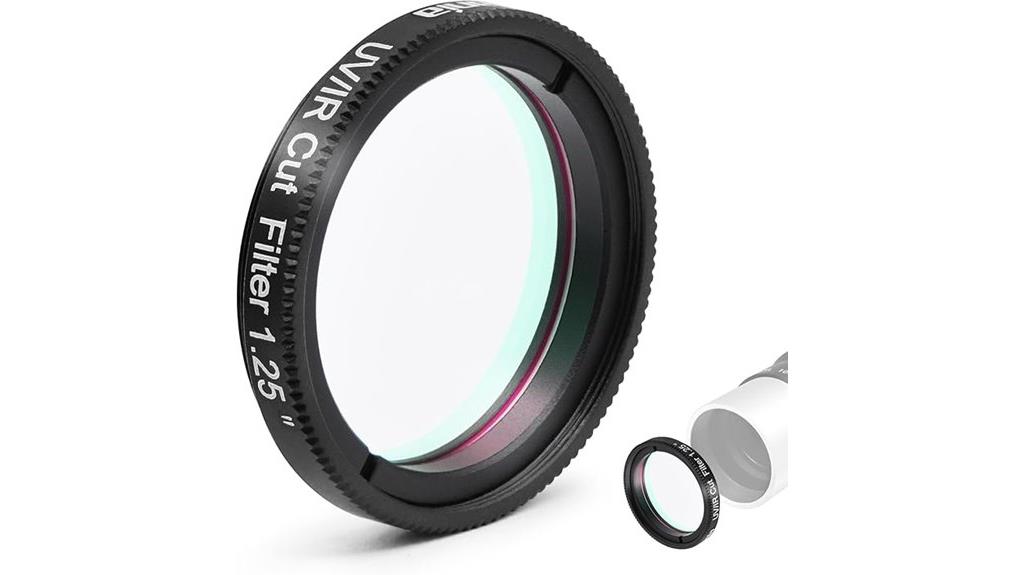
The Astromania 1.25 IR/UV Blocking Filter stands out for anyone aiming to capture sharp, detailed planetary images. It blocks UV and IR wavelengths while allowing only visible light (400-680nm) through, ensuring your images stay focused and clear. This filter is especially effective when using CCD cameras or webcams, as it enhances detail and reduces blurriness caused by IR interference. Its durable aluminum casing makes it easy to handle during observations, and it also protects your eyes from harmful UV rays. Overall, this filter is a reliable choice for planetary imaging enthusiasts seeking high optical quality and sharp results.
Best For: planetary imaging enthusiasts using CCD cameras or webcams who want to capture sharp, detailed images of planets while protecting their eyes from UV rays.
Pros:
- Effectively blocks UV and IR wavelengths, enhancing image clarity
- Durable aluminum casing for easy handling during observations
- Protects eyes from harmful UV rays and potential cataracts
Cons:
- Narrow band of light transmission (400-680nm) may limit use for other astronomical imaging needs
- Requires proper alignment and handling to maximize image quality
- May be more expensive than basic filters without IR/UV blocking features
Astromania 3-Piece Planetary Imaging Filter Set (UV/Methane/IR)
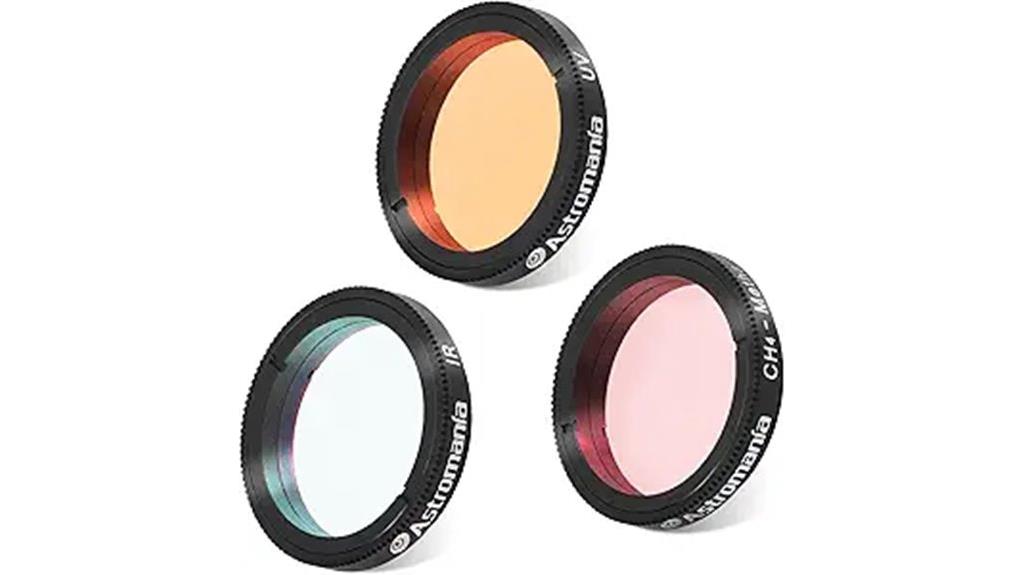
Astronomania’s 3-Piece Planetary Imaging Filter Set stands out for astrophotographers seeking specialized filters to enhance monochrome planetary imaging. This set includes UV, infrared, and methane filters, each designed to reveal unique atmospheric details. The UV filter captures atmospheric structures by blocking unwanted wavelengths, while the IR filter improves image clarity and steadiness under poor seeing conditions. The methane filter transmits a narrow 890nm band, revealing high-altitude atmospheric features. Packaged in a protective case, these filters are lightweight and tailored for imaging only, making them an excellent choice for serious planetary imagers aiming for professional-quality results.
Best For: amateur and professional astrophotographers seeking specialized filters to enhance monochrome planetary imaging and reveal atmospheric details.
Pros:
- Offers professional-grade UV, IR, and methane filters at an affordable price point.
- Enhances planetary imaging by revealing atmospheric structures and high-altitude features.
- Comes with a protective case and foam inserts for safe storage and transportation.
Cons:
- Filters are designed for imaging only and require a monochrome camera; not suitable for color imaging.
- The UV filter’s effectiveness may be limited by telescope optics and camera sensitivity.
- Narrow bandwidth of the methane filter may require precise focusing and setup for optimal results.
SVBONY UV IR Cut Block Filter for DSLR Camera and Telescope

If you’re looking to improve image clarity in astrophotography or webcam modifications, the SVBONY UV IR Cut Block Filter is a solid choice. Designed for digital cameras, DSLRs, CCDs, webcams, and telescopes, it blocks unwanted UV and IR light to enhance sharpness. Compatible with standard 1.25-inch threads, it fits eyepieces and adapters easily, and includes a webcam adapter with a built-in filter thread. The low-reflection multi-coating and striate-free substrate guarantee high image clarity. While the thread size is actually 1.12 inches, not 1.25 inches as claimed, users find it effective for protecting sensors and improving image quality across various setups.
Best For: astronomers, astrophotographers, and webcam modders seeking to enhance image sharpness by blocking UV and IR light in telescopic and digital camera setups.
Pros:
- Effective UV/IR blocking for improved image clarity and sharpness
- Compatible with standard 1.25-inch threads and includes a webcam adapter for versatile use
- High-quality low-reflection multi-coating and striate-free substrate ensure clear, undistorted images
Cons:
- Actual thread size is 1.12 inches, not the claimed 1.25 inches, which may affect fitting compatibility
- Some users have experienced sizing issues or difficulty with thread fitment
- Slight discrepancies in product dimensions and descriptions require verification before purchase
ICE 1.25 UV IR Cut Filter Optical Glass Multi-Coated MC for Telescope

Designed for astronomers and astrophotographers seeking sharp, contrast-rich images, the ICE 1.25 UV IR Cut Filter Optical Glass Multi-Coated MC effectively blocks unwanted UV and IR light. It cuts wavelengths below 390nm and above 750nm, transmitting 99.4% of visible light between 400-700nm. The multi-coated optical glass reduces atmospheric haze, enhancing image clarity. Fits any telescope with a 1.25-inch eyepiece, including popular brands like Celestron, Orion, and Meade. Weighing just 2 ounces and coming with a protective case, it’s ideal for both visual astronomy and daytime photography, delivering improved contrast and haze reduction.
Best For: amateur astronomers and astrophotographers seeking to improve image contrast and reduce atmospheric haze in visual and daytime photography using 1.25-inch telescope eyepieces.
Pros:
- Effectively blocks UV and IR wavelengths, enhancing image clarity and color accuracy.
- Multi-coated optical glass reduces atmospheric haze and improves contrast.
- Compatible with popular telescope brands like Celestron, Orion, and Meade.
Cons:
- May be less effective than specialized IR filters for certain IR-sensitive applications.
- Slightly limited in IR light blocking compared to dedicated IR filters.
- Price point around $20, which is reasonable but might be considered modest for high-end astrophotography needs.
ICE 1.25 UV IR Cut Filter Optical Glass Multi-Coated MC for Telescope

Looking to enhance your telescope’s image clarity? The ICE 1.25 UV IR Cut Filter is a great choice. It’s compatible with any 1.25-inch eyepiece, including popular brands like Celestron, Orion, and Meade. Made from durable optical glass with multi-coatings, it effectively blocks UV rays below 390nm and IR rays above 750nm, while transmitting 99.4% of visible light between 400-700nm. This reduces atmospheric haze and glare, resulting in sharper, clearer images. Its compact, lightweight design makes it easy to handle and transport. Plus, it comes with a protective storage case, ensuring your filter stays safe when not in use.
Best For: Amateur astronomers and telescope enthusiasts seeking to improve image clarity by reducing atmospheric haze and glare during observations.
Pros:
- Effectively blocks UV rays below 390nm and IR rays above 750nm, enhancing image sharpness.
- Compatible with any 1.25-inch eyepiece from popular brands like Celestron, Orion, and Meade.
- Durable multi-coated optical glass construction with a protective storage case for longevity and convenience.
Cons:
- May slightly reduce overall light transmission compared to unfiltered views.
- Requires handling with care to avoid scratches or smudges on the coatings.
- Slightly more expensive than basic filters without multi-coating features.
Factors to Consider When Choosing 1.25 Inch UV IR Cut Filter
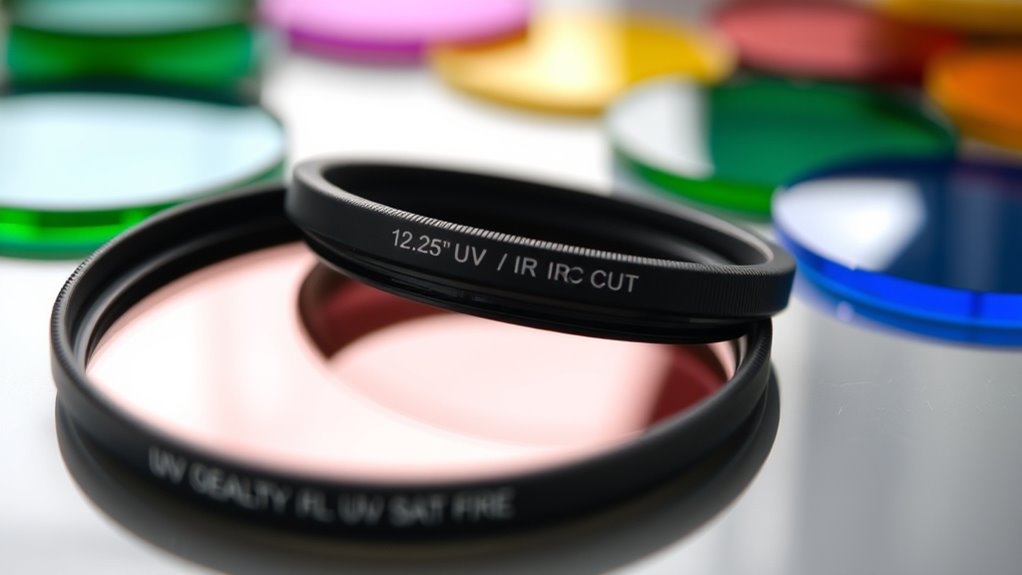
When selecting a 1.25-inch UV IR cut filter, I consider how well it fits my camera and telescope connections to guarantee compatibility. I also look at the optical coating quality and light transmission range to get the clearest images. Finally, I check the filter’s durability, build, size, and threading to match my setup and withstand regular use.
Compatibility With Equipment
To guarantee your UV IR cut filter works seamlessly with your equipment, it is vital to verify that it has a standard 1.25-inch (31.75mm) threaded fitting compatible with your telescope eyepieces or camera adapters. Check that the thread size matches your gear’s specifications, such as M28.5 x 0.6mm, to ensure a proper fit. Additionally, confirm the filter’s physical dimensions and weight are suitable for your setup to prevent issues with clearance or stability. It’s also important to verify that the filter’s optical coatings are designed for your desired transmission range without causing vignetting or image degradation. Finally, confirm compatibility with your camera type—whether DSLR, CCD, or webcam—and that it integrates smoothly with your existing accessories.
Optical Coating Quality
Optical coating quality plays a crucial role in guaranteeing your UV IR cut filter delivers sharp, clear images. High-quality coatings reduce internal reflections and minimize flare, boosting overall image contrast. Multi-layer coatings are designed to maximize light transmission—usually above 96%—while effectively blocking UV and IR wavelengths. Durability is also key; superior coatings prevent degradation over time, even with environmental exposure. Well-applied coatings create striation-free, plane-parallel surfaces that eliminate image artifacts, maintaining clarity during astrophotography. The quality of these coatings directly influences a filter’s ability to suppress unwanted wavelengths without sacrificing brightness or detail. In short, investing in a filter with excellent optical coating quality ensures consistent performance, vibrant images, and long-lasting reliability.
Light Transmission Range
Choosing the right 1.25-inch UV IR cut filter involves understanding its light transmission range, which directly impacts image quality. Most filters transmit light from about 400 to 700 nm, allowing visible wavelengths through while blocking UV and IR outside this spectrum. Some filters have a narrow band, like 450-520 nm, which can enhance specific details such as nebulae or planetary features. High-quality filters often transmit over 96% of light within their range, maximizing brightness and contrast. Broader ranges are more versatile, capturing most of the visible spectrum and providing better overall image clarity. Knowing the exact transmission range helps guarantee compatibility with your equipment and targets, leading to sharper, more natural images with accurate colors. This is vital for achieving crystal-clear astrophotography and photography results.
Durability and Build
When selecting a 1.25-inch UV IR cut filter, durability and build quality are crucial factors that guarantee long-lasting performance and reliable results. A sturdy frame, often made from aluminum alloy or high-quality metal, helps the filter withstand impacts and environmental stress. Multi-coatings on the optical glass not only boost light transmission but also protect against scratches, dust, and moisture, extending the filter’s lifespan. Using striate-free, plane-parallel substrates ensures consistent optical performance and minimizes internal reflections that could cause damage over time. Weather-sealed constructions offer added defense against dust and water, making the filter suitable for outdoor use. Finally, secure threading and robust housing prevent accidental damage and keep the filter firmly attached during handling or stacking.
Size and Threading
Ensuring the filter’s diameter matches your camera or telescope’s thread size is vital for a secure and stable fit. Most 1.25-inch filters are designed to fit standard eyepiece or lens threads, but verifying the exact size is critical. Check the thread specifications, such as M28.5 x 0.6mm or the standard 1.25-inch diameter, to confirm compatibility. Some filters feature double-threaded or stacking designs, allowing multiple filters to be used together without interference. It’s also important to verify the filter’s thread size and design work with your accessories like adapters or zooms. Since thread sizes can vary slightly, measuring your equipment beforehand can prevent fitting issues and ensure a snug, secure connection.
Price and Value
The price of a 1.25-inch UV IR cut filter often reflects its optical quality, durability, and coating technology. Higher-priced filters typically feature advanced multi-coatings that enhance light transmission and reduce reflections, resulting in clearer images and longer-lasting performance. While budget options can effectively block UV and IR wavelengths, they may have less durable coatings or lower optical clarity, which could impact image quality over time. The overall value depends on balancing cost with performance, build quality, and lifespan. Investing a bit more can pay off with sharper images and increased durability, making the filter a better long-term choice. Comparing prices and features helps ensure you choose a filter that offers the best optical benefits within your budget.
Brand Reputation
Brand reputation plays a significant role in choosing a 1.25-inch UV IR cut filter, as it often reflects the overall quality and reliability of the product. Reputable brands typically deliver consistent quality, dependable performance, and excellent customer support, which are essential for protecting your equipment and achieving clear images. Well-known brands invest in high-quality optical coatings and durable materials, ensuring long-lasting effectiveness against UV and IR light. Customer reviews and ratings for established brands tend to be more positive, indicating higher satisfaction. Additionally, trusted brands usually offer warranties and after-sales service, providing peace of mind with your purchase. Choosing a reputable brand reduces the risk of ending up with counterfeit or subpar filters that could underperform or harm your gear.
Frequently Asked Questions
How Do UV IR Cut Filters Impact Astrophotography Image Quality?
UV IR cut filters greatly improve my astrophotography by reducing unwanted ultraviolet and infrared light that can cause haziness or color distortions. They enhance the clarity and sharpness of stars and celestial objects, allowing me to capture more accurate and vivid images. Without these filters, my photos often suffer from glare and blurring, so I always use them to guarantee the best possible image quality when shooting the night sky.
Can UV IR Cut Filters Be Used With Smartphone Cameras?
Yes, you can use UV IR cut filters with smartphone cameras, but it’s not always straightforward. I’ve found that attaching a clip-on filter designed for smartphones works best, helping reduce unwanted UV and IR light, which can improve photo clarity. Keep in mind, smartphone lenses are small and fixed, so you might not see a huge difference, but it’s worth trying for clearer, more vibrant images, especially outdoors.
What Is the Typical Lifespan of a 1.25-Inch UV IR Cut Filter?
Think of a UV IR cut filter as a trusty shield for your camera’s eye—its lifespan typically spans 5 to 10 years, depending on how often you shoot and how well you care for it. I’ve found that gentle cleaning and avoiding harsh environments can extend its life. Over time, minor scratches or dust may appear, but with proper care, it’ll keep protecting your shots for many years.
Are There Any Compatibility Issues With Specific Telescope Models?
Yes, some filters may not be compatible with certain telescope models, especially if they have unique thread sizes or mounting systems. I recommend double-checking your telescope’s specifications and ensuring the filter’s size and thread match. If you’re unsure, contacting the manufacturer or retailer can save you from compatibility issues. Ultimately, choosing a high-quality, standard 1.25-inch filter usually works well with most telescopes.
How Do Multi-Coated Filters Enhance Image Clarity and Durability?
Multi-coated filters markedly boost image clarity and durability. I’ve found that they reduce reflections and glare, resulting in sharper, clearer images. The coatings also protect the glass from scratches, dirt, and moisture, making them last longer. This durability means I don’t have to replace filters often, saving me money and hassle. Overall, multi-coated filters are a smart investment for better, more reliable photography results.
Conclusion
Choosing the right 1.25-inch UV IR cut filter can truly be a game-changer for your astrophotography. With so many options out there, it’s important to pick one that suits your needs and helps you see the universe in a whole new light. Remember, it’s not just about filtering out unwanted light—it’s about capturing those stunning, crystal-clear images that make your efforts worthwhile. When you find the right filter, the sky’s the limit!
